September 27, 2019
Air Date: September 27, 2019
FULL SHOW
SEGMENTS
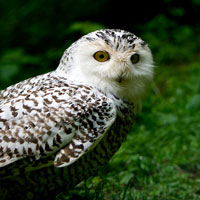
Silencing Spring
View the page for this story
Birds in North America have declined by as many as 3 billion since the 1970s, according a new study reported in the journal Science. The researchers note many grassland and shorebirds have been hit especially hard with more than 50 percent losses. Host Steve Curwood spoke with Arvind Panjabi, Avian Scientist at the Conservancy of the Rockies and co-author in the study. (08:57)
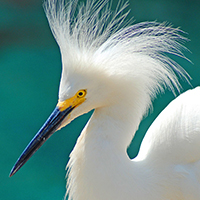
BirdNote®: Snowy Egrets - Killer Hats
/ Michael SteinView the page for this story
The Victorian era proved deadly for millions of birds, killed so that the plumage of snowy egrets and other showy birds could decorate fashionable ladies’ hats in Europe and North America. As BirdNote®’s Michael Stein explains, in 1910 outraged citizens finally rallied to save these birds on the doorstep of extinction. (01:58)
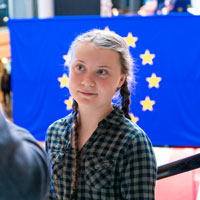
Kids Versus the Climate Crisis
View the page for this story
Swedish teen Greta Thunberg and fifteen other young climate activists from around the planet have filed a complaint with the United Nations' Committee on the Rights of the Child on the grounds their human rights are being violated by international failures to avert the climate emergency, as global warming is currently on track to lead to the deaths of billions of children by the end of the century. Host Steve Curwood and human rights attorney Scott Gilmore, who is representing the youth complainants, discuss how the complaint could make a difference. (10:22)
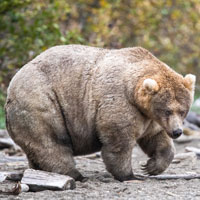
Fat Bear Week!
View the page for this story
Some people play fantasy football to unwind, some participate in March Madness, and others vote in Fat Bear Week. Organized by the Katmai National Park and Preserve in southern Alaska, Fat Bear Week is a yearly competition that invites the public to choose and celebrate the brown bears that fatten up on salmon before hibernation. Katmai Natl Park Media Ranger Naomi Boak joined Living on Earth’s Bobby Bascomb to talk about why a fat bear is a healthy bear and how to join the fun. (09:36)
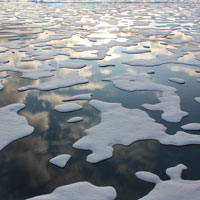
Beyond the Headlines
/ Peter DykstraView the page for this story
In this week's trip beyond the headlines, Peter Dykstra joins Host Steve Curwood to take a look at recurring devastation left behind by storms, and how quickly the media moves on from covering them. Then, the two discuss which nations are on track to meet their 2015 Paris Climate Accord goals and which are falling behind. Next Peter and Steve talk about a new law in Florida that could have a chilling effect on environmental challenges to projects. Finally, the two discuss the 2019 Arctic ice cover minimum as well as reminisce about a famous television evangelist who believed that he could pray a storm away. (04:13)
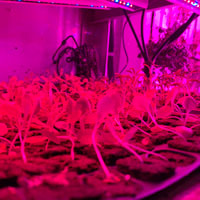
Container Farming in the City
/ Aynsley O'Neill and Jay FeinstienView the page for this story
Modern industrial agriculture is a resource-intensive endeavor, requiring massive amounts of land, water, and energy. Some urban farmers are thinking outside the box by bringing their farms inside the box in the form of shipping containers. Living on Earth's Jay Feinstein and Aynsley O'Neill took a trip to Corner Stalk Farms, in East Boston, Massachusetts to find out more. (11:51)
Show Credits and Funders
Show Transcript
HOSTS: Steve Curwood
GUESTS: Naomi Boak, Scott Gilmore, Arvin Panjabi
REPORTERS: Peter Dykstra, Michael Stein, Aynsley O’Neill, Jay Feinstein
[THEME]
CURWOOD: From Public Radio International – this is Living On Earth.
[THEME]
CURWOOD: I’m Steve Curwood.
Scientists warn that North American birds are headed for catastrophe.
PANJABI: We've lost nearly a third of all of our birds on the continent, that’s U.S. and Canada. And I think there’s a number of reasons for that. So, we’re losing landscape diversity, we’re losing plant species and insect life within these areas, and that is being reflected in the bird populations.
CURWOOD: Also, Katmai National Park in Alaska is holding its annual fat bear contest.
BOAK: It’s like March Madness for bears. We create brackets, and we have head to head matchups, and people from all over the world vote for who they think is the fattest bear this year at the Brooks River.
We’ll have those stories and more this week on Living on Earth – Stick Around!
[NEWSBREAK MUSIC: Boards Of Canada “Zoetrope” from “In A Beautiful Place Out In The Country” (Warp Records 2000)]
[THEME]
Silencing Spring
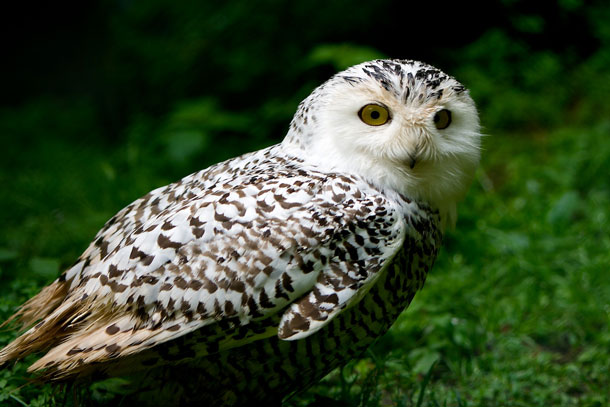
The population of snowy owls has declined 64 percent since 1970, according to the 2019 Science Magazine study. (Photo: Rainer Hungershausen, Flickr, CC BY-NC-ND 2.0)
CURWOOD: From the Jennifer and Ted Stanley Studios at the University of Massachusetts Boston, this is Living on Earth. I’m Steve Curwood.
For proof that the planet is suffering what some call mass extinction number six, you’d need look no further than the birds of North America. Overall the population of birds in the US and Canada has plummeted over the past fifty years by nearly 3 billion, a loss of some 30 percent. Even among more common birds the losses are steep, according to a study published in Science, and conservationists are calling it a crisis. It’s even worse for some. The little yellow and brown Cape May Warblers have declined some seventy percent since 1967.
[SFX CAPE MAY WARBLER (SONG MAY 1, 1982)]
CURWOOD: And at the same time Snowy owls are also down 64 percent.
[SFX SNOWY OWL SOUND]
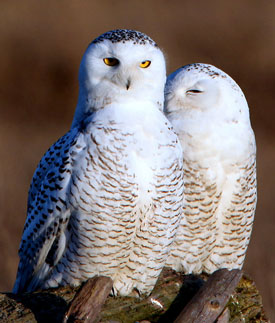
A pair of snowy owls. (Photo: Nigele, Flickr, CC By 2.0)
CURWOOD: The study recently published in Science does not link the avian losses to certain causes, but climate disruption, industrial farming, coastal development and the sharp decline in insects are undoubtedly factors. Arvind Panjabi an Avian conservation scientist at the Bird Conservancy of the Rockies and co-author of the study joins us now. Welcome!
PANJABI: Thank you. It's a pleasure to be here.
CURWOOD: Talk to me about some of the birds that are disappearing that you found in your study. Which ones might be fairly familiar to people, and which ones are, well, not so familiar?
PANJABI: You know, one thing that surprised us was that one of the groups of birds that has declined the most are birds that were introduced into North America well over a century ago. The most common birds that people see in our cities and towns, and also in our farmlands, these are the house sparrow, the European starling and the rock pigeon. They're the ones that we generally tend to think of as being most resilient. And now those three species alone make up nearly 800 million birds that we've lost. And I think there's a number of reasons for that. Our agricultural systems have intensified over the last 50 years, using increasing pesticides and herbicides in order to support large monocultures. So we're losing landscape diversity, we’re losing plant species and insect life within these areas, and that is being reflected in the bird populations.
CURWOOD: What about the snowy owls?
PANJABI: Yeah, snowy owls are an interesting bird that we're just learning more about. And most of the snowy owls are shared across the globe, meaning that their populations may be concentrated in Canada and Alaska in one year, and then be over in Russia and Scandinavia in another year. So, the estimate of snowy owls is only around 15,000 pairs globally. Of course, this is a species that depends on abundant small mammal populations, which are tied to climate, so a lot of vulnerability for the species due to climate change.
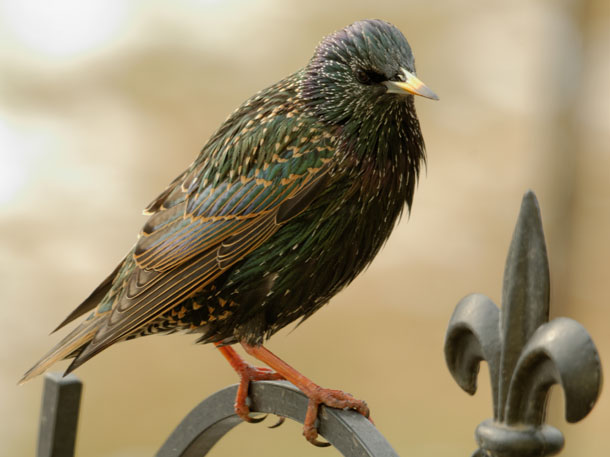
European Starlings are considered a resilient invasive bird, yet they are also in decline. (Photo: Ellen & Tony, Flickr, CC BY-NC-ND 2.0)
CURWOOD: Now, your study is saying that species along grasslands, black finches, sparrows, those are the ones that are declining the most with the loss of almost a billion birds there alone. Why are those birds so vulnerable? What's going on? Why is this happening?
PANJABI: Grasslands of course, have been the center for cropland, agriculture development, and expansion since Europeans arrived in North America. And that trend has been continuing right up through today. There's also been a lot of changes in the structure and composition of grasslands over time, especially in the southern part of our Great Plains that extends down into Mexico and the Chihuahuan desert, which are the primary wintering grounds for the birds from the Northern Great Plains. Those grasslands have shrunk considerably over the last century and a half due to encroachment of the surrounding desert, largely as a result of long term overgrazing that has resulted in a loss of fine fuels and therefore a loss of fire that could help control the encroachment of shrubs.
CURWOOD: Now, what about the shoreline losses?
PANJABI: So shoreline losses are affecting a number of bird species both in our coastal marshes and in the mud flats and beaches. Now, there's been considerable development along our coastlines, of course, these are places that humans love to live and recreate. And these birds that use them; so we have two main groups of birds we have Marsh birds, birds like the black rail, which has just plummeted, virtually disappeared from the eastern United States, the marshes there. And other birds like the salt marsh Sparrow, which is perhaps sadly, going to be the next bird that goes extinct in this country, because its populations are plummeting so fast. And with sea level rise, and higher high tides, the birds get flooded out of their nests.
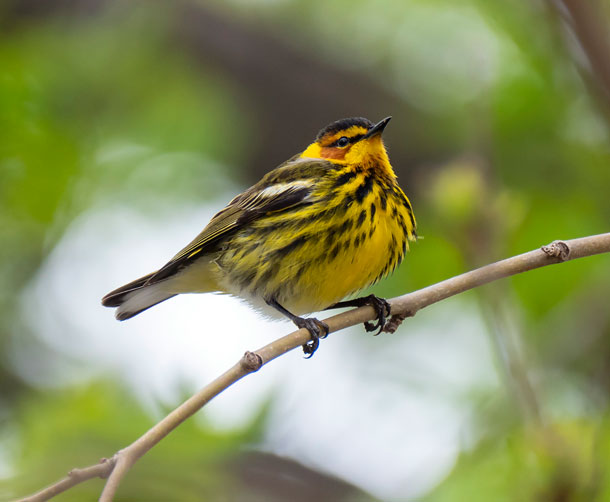
Cape May Warblers are North American birds that winter in the Caribbean. (Photo: Doug Greenberg, Flickr, CC BY-NC 2.0)
CURWOOD: By the way, your report points out that wetland birds are actually on the rise in the U.S. Seems to be the only kinds of birds that are on the rise. Why is that?
PANJABI: That's a good observation. You know, historically, we've lost a lot of wetlands here in North America, and in 1972 we passed the Clean Water Act, which protected wetlands. And our wetland birds have begun to recover. We also banned DDT, which was affecting birds at their reproductive capabilities. Plus, in the 1980s, we passed the North American Wetlands Conservation Act, which provided upwards of $90 million a year to support wetlands protection across North America, from Canada to Mexico and the Caribbean. So we've invested in wetlands conservation, and we've got laws on the books to protect wetlands. Unfortunately, many of those laws are being undone now. And sadly, places like the prairie potholes are now being drained despite having received decades of protection from the Clean Water Act.
CURWOOD: And what birds are dependent on the prairie potholes?
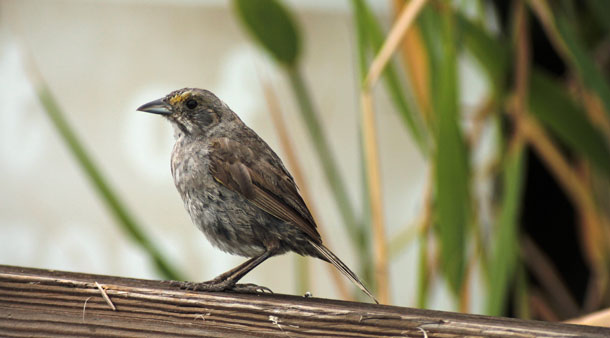
Salt Marsh Sparrows are in extreme decline due to sea level rise. (Photo: Fishhawk, Flickr, CC BY 2.0)
PANJABI: Well, our waterfowl populations, precisely those that have been doing so well over the last few decades. So we're at risk of losing what we've recovered now, because of the change in the interpretation of the Clean Water Act that no longer protects those isolated wetlands.
CURWOOD: To what extent do you think that groups like Ducks Unlimited, those who would hunt waterfowl, have made the difference? Because you say waterfowl are actually going up in this country.
PANJABI: Right. Well, they've actually made a difference. Those federal dollars from the North American Wetlands Conservation Act, those need to be matched one to one with non-federal dollars. So, groups like Ducks Unlimited have been very successful at raising money to match those federal dollars and protect wetlands. And those benefit not just ducks, but other wetland-dependent birds and animals as well.
CURWOOD: Even though some would say ‘but they want to kill ducks’.
PANJABI: Yes, but they do it on a sustainable basis. So, the hunting of ducks clearly has not contributed to the decline of ducks. In fact, it's the opposite. It's generated revenue that has allowed conservation to move forward rapidly, much more so than for non-game species.
CURWOOD: What about global policy to address this loss? If we keep losing 3 billion birds every generation or so, we're going to be, well, out of birds.
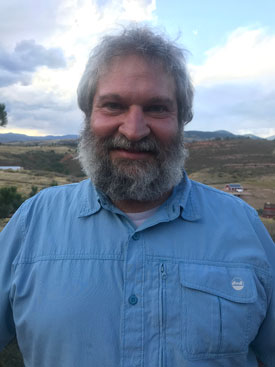
Study co-author Arvind Panjabi is the Avian Scientist at Bird Conservancy of the Rockies. (Photo: Arvind Panjabi, Bird Conservancy of the Rockies)
PANJABI: That's right. These birds cross international boundaries and so we need to work with governments from other countries to ensure their protection. We very badly need the cooperation of the Mexican government to help protect the very limited grasslands that are on the wintering grounds for these birds in Northern Mexico.
CURWOOD: Arvind, what gives you hope in this?
PANJABI: Well, that is a very depressing study, but there's actually great hope. We've been here before, believe it or not. Around 1970, when we banned DDT, we had identified a specific problem with the effects of DDT, impacting the eggs of raptors in particular, such as the bald eagle, the peregrine falcon the osprey, and when we banned that pesticide, those populations recovered. So, today we find ourselves at a much more challenging crossroads, because we've identified declines in so many groups of birds. The solutions are no doubt more complex. Yet, there's been a lot of good work done at identifying the needs for each of these declining bird species. So right now there is an act that's been introduced into Congress. It's called the Restore America's Wildlife Act and what it would do is direct 1.2 billion in offshore oil revenues towards the states to implement these state wildlife action plans. So that would provide a real boost in the arm for state agencies trying to address the needs of hundreds of species for which they previously have not had any funding to do so.
CURWOOD: Arvind Panjabi is a conservation scientist at the Bird Conservancy of the Rockies. Thanks for taking this time with me today.
PANJABI: Thank you, Steve it's a pleasure to be with you.
Related links:
- Science Mag | “Three Billion North American Birds Have Vanished Since 1970, Surveys Show”
- The New York Times | “Birds are Vanishing from North America”
- #Bring Birds Back: 7 Simple Actions to Help Birds
[MUSIC: BIRDNOTE THEME]
CURWOOD: As Arvind Panjabi pointed out, this isn’t the first time we’ve seen alarming losses of birds. And as Bird Note’s Michael Stein explains, more than a century ago people rallied to save some birds on the doorstep of extinction.
BirdNote®: Snowy Egrets - Killer Hats
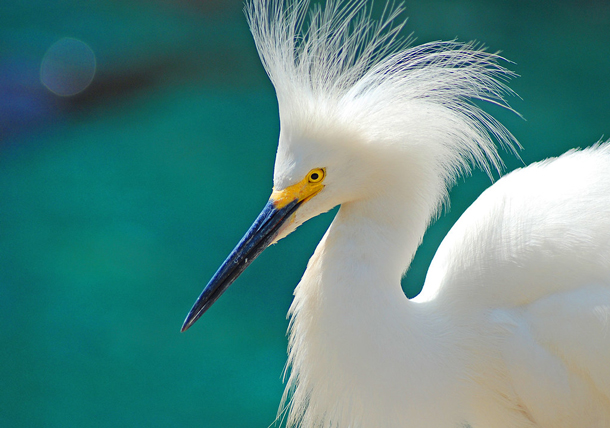
Snowy egret plumage was once prized as materials for fancy hats. (Photo: Pamala Wilson)
BirdNote®
Snowy Egrets – Killer Hats
[Call of the Snowy Egret, with background of Okefenokee Swamp, Georgia]
The beauty of the small, slender Snowy Egret is in its fine white feathers and long, lacy plumes. You’ll find them wading in open waters and wetlands throughout much of the United States. But once, Snowy Egrets were rare.
During the late 1800s, five million birds a year including Snowy Egrets were killed so their feathers — and sometimes even the whole birds — could be added to the hats of fashionable ladies in Europe and America. In 1886, Snowy Egret plumes were worth twice as much as gold.
[Ambient urban city, 1880s]
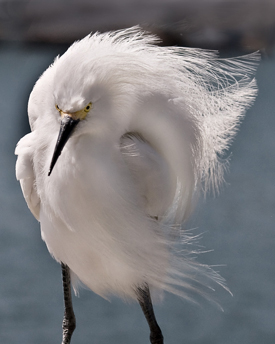
In the 1800s, millions of snowy egrets and other birds were killed every year for the sake of fashion. (Photo: Steve Corey)
In a few hours during a walk through the streets of New York City, ornithologist Frank Chapman counted forty species of birds on the hats of the women he passed, including warblers, waxwings, Blue Jays, Bobwhites, and of course, Snowy Egrets.
The plundering for plumes continued until around 1910, when outraged citizens forced the passage of laws that reduced the slaughter. These are largely the same laws that protect many birds today.
“Killer hats” are now a thing of the past, and we can all appreciate the Snowy Egret in its natural habitat today.
[Call of the Snowy Egret but heavy on swamp ambient]
###
Written by Chris Peterson
Producer: John Kessler
Managing Producer: Jason Saul
Editor: Ashley Ahearn
Associate Producer: Ellen Blackstone
Assistant Producer: Mark Bramhill
Narrator: Michael Stein
Nature sounds provided by The Macaulay Library of Natural Sounds at the Cornell Lab of Ornithology, Ithaca, New York. Snowy Egrets [59443-2] recorded by W.W.H. Gunn; Swamp by T. Wiewandt.
© 2019 BirdNote September 2019
https://www.birdnote.org/show/snowy-egrets-killer-hats
CURWOOD: For pictures of the snowy egret, check out our website, LOE.org.
Related links:
- This story on the BirdNote website
- Audubon: About Snowy Egrets
- Smithsonian: How Two Women Ended the Deadly Feather Trade
- All About Birds: Snowy Egret
[MUSIC: Jerry Leake, “Children’s Song” on Vibrance: Jazz Vibes and World Percussion, by Chick Corea, RhombusPublishing.com]
CURWOOD: Coming up – Youth climate activists at the United Nations Climate Summit file a human rights complaint against 5 countries for failing to protect them from climate disruption. That’s just ahead on Living on Earth.
ANNOUNCER: Support for Living on Earth comes from Sailors for the Sea and Oceana. Helping boaters race clean, sail green and protect the seas they love. More information at sailorsforthesea.org.
[CUTAWAY MUSIC: Jerry Leake, “Children’s Song” on Vibrance: Jazz Vibes and World Percussion, by Chick Corea, RhombusPublishing.com]
Kids Versus the Climate Crisis
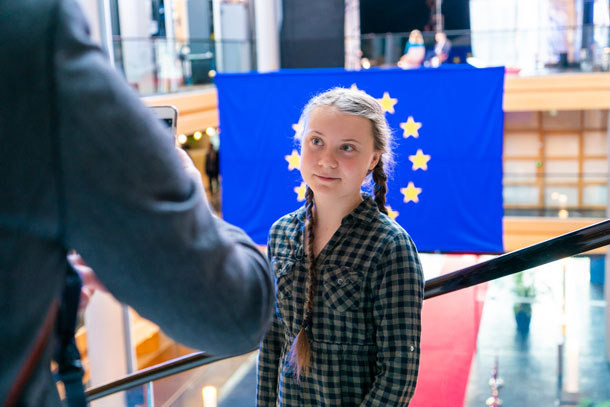
Greta Thunberg is a Swedish environmental activist. (Photo: European Parliament, Flickr, CC BY 2.0)
CURWOOD: It’s Living on Earth, I’m Steve Curwood.
Sixteen year old climate activist Greta Thunberg gave a famous speech on September 23rd at the UN, calling out world leaders for their slow response to the climate emergency.
THUNBERG: This is all wrong, I shouldn’t be up here. I should be back in school on the other side of the ocean. Yet you all come to us young people for hope. How dare you? You have stolen my dreams, and my childhood with your empty words, yet I’m one of the lucky ones. People are suffering, people are dying, entire ecosystems are collapsing. We are in the beginning of a mass extinction, and all you can talk about is money and fairy tales of eternal economic growth. How dare you? For more than 30 years, the science has been crystal clear. How dare you continue to look away and come here saying that you’re doing enough, when the politics and solutions needed are still nowhere in sight? You say you hear us, and that you understand the urgency, but no matter how sad and angry I am I do not want to believe that. Because if you really understood the situation and kept on failing to act then you would be evil, and that I refuse to believe.
CURWOOD: That same day Greta and 15 other young people from around the planet filed a complaint with the UN Committee on the Rights of the Child, charging their rights to a livable planet are being violated. Argentina, Brazil, France, Germany, and Turkey are named in the complaint and Scott Gilmore is a human rights attorney representing the youth. Welcome to Living on Earth, Scott!
GILMORE: Thank you, pleasure to be here.
CURWOOD: Now, this isn't exactly a lawsuit, but rather a formal petition of the United Nations. Tell me, what does that mean?
GILMORE: What this is, is what's called a communication. It's a special form of petition that is submitted to a UN panel of experts that were created, essentially, to oversee compliance with the Convention on the Rights of the Child. This is the most widely ratified human rights treaty in the world. It's been ratified by every country other than the United States. And the Convention is designed to be universal. It protects the rights to life, health, access to culture and education of children throughout the world. And there's an additional Optional Protocol to the Convention, which gives this committee the jurisdiction to receive individual complaints from children alleging violations of their rights. This protocol that gives the committee this jurisdiction, that's only been ratified by 45 countries.
CURWOOD: Let's talk about the details, then, of your complaint. You filed this only against five different nations, Argentina, Brazil, France, Germany, and Turkey. And of those, none are in the top five carbon-emitting countries around the planet. And only Germany is in the top 10. Why were those countries chosen?
GILMORE: Out of those 45 states, that have accepted the jurisdiction of this committee, this complaint is brought against what are really the main emitters among the 45 states. And they're also regional leaders, and members of the Group of 20. They have an influence that really goes beyond their individual emissions of greenhouse gases. They have the ability to influence other states, to stand up to the major emitters, which are, of course, United States, China, India, and the European Union as a whole. And so essentially, if we had jurisdiction over the United States or China, we would be naming them in the complaint most certainly. But these are the five countries that have accepted the jurisdiction of this committee to review their record.
CURWOOD: If I understand your complaint correctly, Scott, should this body find in favor of your petition, these countries could be required to try to persuade the United States and China and India and the rest of the world to get on board to having a robust response to climate disruption.
GILMORE: That's right. Under international human rights law, states have an obligation to prevent environmental threats that they themselves are causing or permitting which impact on human rights. But they also have a very clear legal duty to protect children in their jurisdiction from environmental threats caused by third parties. And so essentially, we're at a stage now in international climate action, where a state like Germany or France, in many ways they've been leaders in pushing for international climate action. But the fact remains, they're not meeting their own domestic targets. And they could be doing much, much more to be protecting children from the emissions of the US and China, which absolutely must be reduced.
CURWOOD: Broadly, what does this petition hope to accomplish?
GILMORE: The goal of our petitioners is really to reframe the issue of climate change, and shift it away from one that seems rather abstract. Under the Paris Agreement, the governments of the world set these thresholds of trying to limit global warming to two degrees of warming by 2100, and to pursue efforts to keep it under 1.5 degrees. What we're trying to argue here is that the real frame, the real way we need to think of this is on the impact of climate change, saying that the world is going to warm to two degrees doesn't strike many people as a nightmare scenario. The reality of it is that that two degrees of warming over the coming decades is going to spell natural disasters, extreme weather events that are going to cost the lives of hundreds of millions of people. This is the consensus scientific view that the UN has reached through the Intergovernmental Panel on Climate Change report that was released in 2018, where the stark conclusions were that even this two degree threshold that the Paris Agreement set is one in which 150 million people would be estimated to be killed just by the exacerbated air pollution caused by climate change. In that scenario, the argument we're really trying to make is that we aren't talking about failing to meet your voluntary commitments under the Paris Agreement, we're talking about jeopardizing the lives of millions of children. And this is a human rights violation on a scale that we really haven't dealt with before through the UN system.
CURWOOD: Of course, children face perhaps the longest term risk from climate disruption, but every living being on the planet really is at risk from this. What's the benefit of bringing this case as a matter of children's rights in front of the UN?
GILMORE: I think the impact of framing this as a child rights issue is that the Convention on the Rights of the Child is nearly universally ratified. Every country other than the United States is bound by these commitments. And the actual legal ruling of the committee is an interpretation of the convention. What we are trying to establish is setting a precedent that the climate crisis is a child's rights crisis. That although the Convention on the Rights of the Child says nothing about climate change, that in fact, climate change is the paramount children's rights issue of today. And should the committee issue that ruling, that's going to apply to every country in the world, except the United States, at least under that treaty.

Scott Gilmore is one of the attorneys who will be representing the children during their complaint. (Photo: Courtesy of Hausfeld LLP)
CURWOOD: So, how does your case fit in with the Juliana versus the US children's case that's been filed in federal court?
GILMORE: Our hope is that this case will continue to add momentum to the movement that has really been started, both by the Juliana case, and by very important climate litigation that's been brought around the world. There have been cases successfully brought in the Netherlands; the famous Urgenda case where a Dutch court ordered the Dutch government to revisit its emissions reductions target, set more ambitious goals, and specifically found that failing to meet those goals would be a human rights violation. The key is that each of these cases, I think, is incrementally working to build a new political consensus and an awareness that time is really running out.
CURWOOD: There's a lot of concern about climate disruption, Scott, but what is your concern about what's going on right now, with the Paris Climate Agreement?
GILMORE: Our main concern is that states have set inadequate emissions reduction targets under the Paris Agreement, and then failed to meet even those inadequate targets. Just looking at the five respondents states; in our case, Argentina, Brazil, France, Germany, and Turkey. None of these states have reduced emissions or even pledged to reduce emissions on a path that is anywhere consistent with holding global warming below two degrees, never mind 1.5 degrees. All of these states are to exceed three to four degrees of global warming. In the instance of Argentina and Turkey, based on their current policies, if they continue emitting at this rate, and if other countries were to similarly be emitting at this rate and fail to meet their targets, the world would be at four degrees of global warming by 2100. If we're looking at a future of four degrees of warming, what we're looking at is potentially jeopardizing the lives of 2 billion children. That's the stark reality of looking at these numbers. They seem like small numbers, but the human impact is astronomical.
CURWOOD: Scott, how soon do you think you might hear what's going to happen to your petition?
GILMORE: Our hope is that we will be able to obtain a ruling on the jurisdiction and admissibility issues within the next six months. And we are going to push for a decision on the human rights impact of the failure to meet these climate goals within one year. And that's a critical time frame because in 2020, the next round of reduction pledges will be made under the Paris Agreement. And frankly, if this round doesn't make the sufficient reductions, we really don't see any possibility of the Paris Agreement succeeding. It's now or never.
CURWOOD: Scott Gilmore is a human rights attorney with Hausfeld LLP. Thank you so much for taking the time with us today.
GILMORE: Thank you.
Related links:
- Children Vs. Climate Crisis official website
- Hausfeld LLP’s Press Release
- The Guardian | “Greta Thunberg to World Leaders: ‘How Dare You – You Have Stolen My Dreams and My Childhood’ – Video”
- CNN | “Greta Thunberg and 15 Other Children Filed a Complaint Against Five Countries Over the Climate Crisis”
- About Juliana vs. United States
[MUSIC: Secret Garden/Davy Spillane, “Pastorale” on Songs From a Secret Garden, by Rolf Lovland, Philips]
Fat Bear Week!
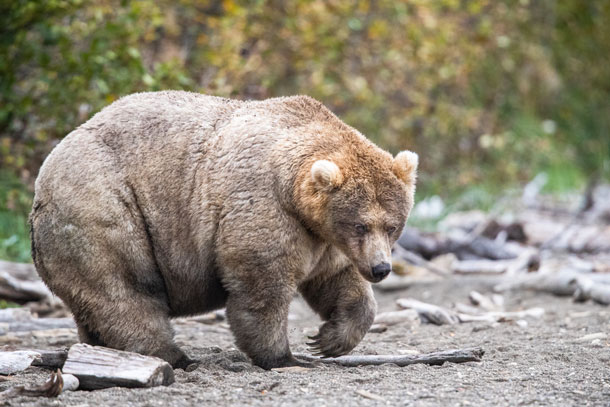
Brown Bears at Katmai National Park and Preserve in Alaska, like 435 Holly, gain intense amount of weight during the spring and summer to prepare for winter hibernation. (Photo: 435-NPS Photo/N. Boak)
CURWOOD: The rangers at Katmai National Park in southern Alaska are hosting a fishing derby, but in this case it’s not the biggest fish that wins, it’s the biggest one who catches fish. These contestants are very large bears, the eight and nine footers of Katmai, which is home to the largest concentration of brown bears in the world. These bruins can lose as much as one third of their weight while sleeping through the long cold Alaska winter, so summer and fall, they pack on extra pounds with sockeye salmon. And to let the public decide which bear appears to have caught and eaten the most fish, park rangers host a fat bear contest each year. People can watch the live stream of the bears snagging fish on the Brooks River in Katmai and then go to Facebook to vote for the ursine angler they think should be named the fattest. For details of the fat bear tournament Living on Earth’s Bobby Bascomb spoke with Katmai media ranger Naomi Boak.
BOAK: It's like March Madness for bears. We create brackets, and we have head to head matchups. And people from all over the world vote for who they think is the fattest bear this year at the Brooks River. And we have several bear cams here which stream live the activities of the bears all season. These bears are a lot of fun to watch. Really, fat bear week, for us, is not only a celebration of the end of the season, but it's also an interpretive and educational vehicle for us to let the world know about the lives of bears and their struggles and successes. And we're excited to start the competition!
BASCOMB: I was watching the live stream online and it's really fun just to watch these bear stand so stoically, and try and catch the salmon coming upstream. And that's how they're fattening up right now. Right?
BOAK: Yes, and they've been doing that all summer. We have one of the largest sockeye salmon runs here on the Brooks River. And it was a great salmon run; last year was record breaking. And the bears came back nice and healthy. And this year was another great year. The bears are really obese, and they're working very hard to be as fat as they can for their winters hibernation. It's amazing to watch.
BASCOMB: Now, tell me a bit about the bear biology. Why are we looking for the fattest bear? Why is that an indicator of a healthy bear? You know, a good muffin top on top of your bears, what you're really after here.
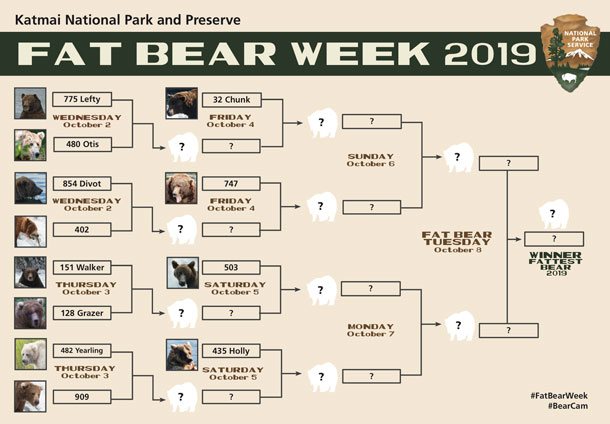
Fat Bear Week uses a March Madness style bracket to keep track of the public votes. (Photo: NPS Photo/N. Boak)
BOAK: In our world where obesity is not a good thing, it's hard for us to get our heads around the fact that obesity is a really good thing for bears. When they go into hibernation in the winter, they're not completely asleep. But they do not eat; they lose maybe 30 to 40% of their fat stores. So if they're not fat enough, they're going to have a hard time surviving the winter. And when they come out of hibernation in early spring, there's not a lot of food around. So they're eating grasses, it's not very nutritional, they will continue to lose weight. And for sows, it's important for them to get fat because they won't get pregnant unless they're fat. With bears, there's what's called delayed implantation. So the bears mate early in the season. Spring and early summer, mostly. But the eggs don't implant in the uterus until the sow is fat enough. So she has to get really fat in order for that egg to implant in the uterus. And if she's fat enough, when she goes to hibernate, that egg will implant in the uterus. And then the cub will be born in the den in January or February, and, it'll be about a pound.
BASCOMB: Wow, very interesting. Now you have some before and after photos on your website of some of these bears, and I gotta say they're pretty shocking. I mean, you can see the same bear when it comes out of hibernation in June, as you mentioned, and again in September, they hardly look like the same animal.
BOAK: No, they don't, which is why we want to celebrate what they've done all summer. And to really let the public know. And it's hard for us to identify the bears from the beginning of the year to the end of the year, they look so different. They change colors, they shed their coats, and the coats are different. And they're, you know, two, three times the size that they were in the beginning of the season.
BASCOMB: Yeah, I've been looking at some photos from last year. And I gotta say some of these bears are colossal. I mean, last year's winner, Beadnose I think her name was, looks more like a furry hippo or something than a bear. Her belly is practically dragging on the ground. Does she have some kind of special technique to get so big, you know, how is she catching her fish better than the other bears?
BOAK: Well, yes, she was very successful. But bears have different fishing techniques. They can be on the lip of a falls, which is a delicate balancing act, but it's a very great position to be in. Beadnose liked to do that. Another technique that the really big guys like is to fish in the jacuzzi, which is the eddy right below the falls. It's where the fish wait to make the jump up the falls. And these bears are big enough. So they can sit down on their haunches and with their front paws, fish. And so they don't have to move. They just have to fish with their front paws. And they get a lot of fish there. Very coveted spot. It's how those big boars get so big and you have to be a pretty dominant bear to maintain that spot. Some bears dive, not a lot of them. And we have a few bears that dive. And there's a very popular technique, especially this time of year, when a lot of floating dead salmon around, that's called snorkeling. Bears don't like to get their ears wet so they will snorkel. And all these techniques are usually combined by most bears to get as fat as they are.
BASCOMB: And how fat are they getting? I mean, how much did Beadnose weigh last year, if you can know? I don't imagine anybody's out there with scales trying to weigh these things. [LAUGHS]
BOAK: This year, our survey team actually took three-dimensional scans of several of the bears and two of the bears, who I won't reveal, because we want to have a fair contest...
BASCOMB: Inside information! [LAUGHS]
BOAK: Inside information! Who we know to be the biggest bears. During the contest, we will reveal their weights, and their volume, and these 3D scans. It's very exciting and hasn't been done before. And it was quite a job for that group to get these scans because they had to get the bears out of the water. They're not under the water very often this time of year.
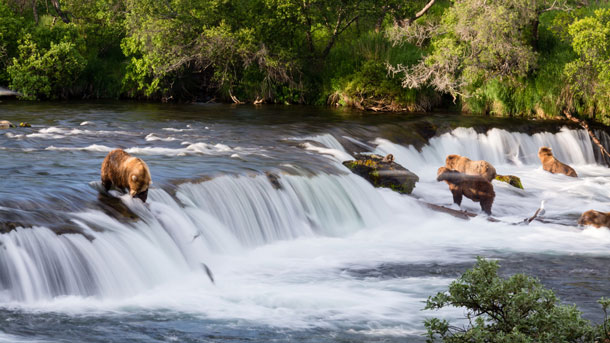
Brooks Falls at Katmai National Park and Preserve is a favorite place for bears to catch salmon. (Photo: Flickr, Christoph Strässler CC BY-SA 2.0)
BASCOMB: Mhm. Well, I imagine there must be some grizzly competition out there!
BOAK: Oooo! [LAUGHS]
BASCOMB: I know I had to, sorry!
BOAK: That's okay!
BASCOMB: Um, what are some of the fan favorites this year?
BOAK: Well, let's see. Bear 747 is certainly a fan favorite. He is humongous. He looked like he was ready to hibernate back in July. Bear 435, Holly, who is a very famous female here. She has had several litters, and she actually adopted a lone yearling a few years ago. So it's made her a fan favorite. She is also ginormous. She does look like a hippo.
BASCOMB: [LAUGHS]
BOAK: She's really, really big. We have some bears, like bear 503, who is a fan favorite for a number of reasons. That bear is a young adult. He's around six years old. He was the bear who was adopted by Holly. So, bear cam viewers have watched this bear grow up into a really fun bear to watch. It's another great thing about the bear cams is, if you watch the bear cams year after year, you get to follow these individual bears. And it's like a soap opera! You learn about their personalities and their adventures. And sometimes it's fun, and sometimes it's sad, but those are three fan favorites that I would talk about.
BASCOMB: Um, do you have a particular bear that you're rooting for this year?
BOAK: I do. But, since I'm helping manage this competition, I can't say. But, secretly I've got a campaign poster in my cabin!
BASCOMB: [LAUGHS] I understand. I understand, you must remain impartial. It's understandable. Well, if somebody wants to get involved and vote for their favorite bear, how can they do that?
BOAK: Sure, everyone can get involved by going to Katmai National Park and Preserve's Facebook page. And starting October 2nd you can vote twice a day. And October 8th, the champion will be announced. The 2019 fattest bear at Brooks!
BASCOMB: All right, Naomi. Well, we will have to have you back on the show once you've crowned a champion and tell us who won.
BOAK: Be happy to return, with a picture of the fattest bear.
BASCOMB: Oh, I can't wait! Maybe this year it'll actually have a belly touching the ground. I think last year's was a couple inches shy.
BOAK: That's a good possibility this year!
CURWOOD: That’s Katmai media ranger Naomi Boak speaking with Living on Earth’s Bobby Bascomb. For links to the live stream of the fat bears of Katmai go to our website LOE.org.
Related links:
- Head over to Katmai National Park and Preserve’s Facebook page to connect with the Fat Bear Week contest
- Take a look at the bears at Brooks River on the bear cams
- More about Katmai Conservancy
- More about Katmai National Park and Preserve
- Check out Katmai’s 2019 bear ebook!
[MUSIC: Jerry Garcia and David Grisman, “Teddy Bears Picnic,” on Not For Kids Only, by John Walter Bratton and Jimmy Kennedy, Acoustic Disc]
CURWOOD: Coming up – Thinking inside the box when it comes to hyperlocal farming. That’s just ahead on Living on Earth.
ANNOUNCER: Funding for Living on Earth comes from you, our listeners, and United Technologies, combining passion for science with engineering to create solutions designed for sustainability in aerospace, building industries, and food refrigeration. UTC companies such as Otis, Carrier, Pratt and Whitney, and UTC Aerospace systems are helping to move the world forward. You can learn more about United Technologies by tuning into the Race to Nine Billion podcast; listen at racetoninebillion.com. This is PRI, Public Radio International.
[CUTAWAY MUSIC: Jerry Garcia and David Grisman, “Teddy Bears Picnic,” on Not For Kids Only, by John Walter Bratton and Jimmy Kennedy, Acoustic Disc]
Beyond the Headlines
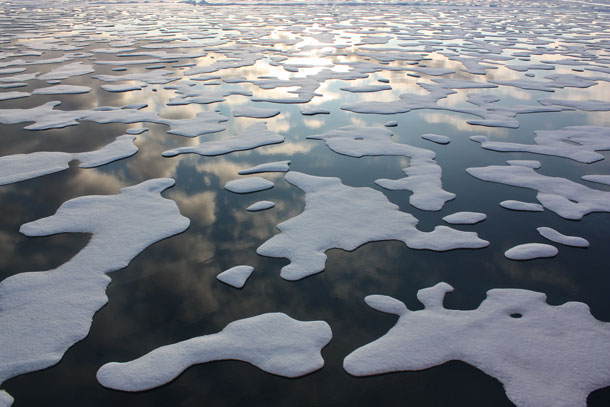
2019 is second on the record for lowest Arctic sea ice levels, according to NASA.
CURWOOD: It’s Living on Earth, I’m Steve Curwood.
Let's turn now to Peter Dykstra. He's an editor at Environmental Health News, that's EHN.org and DailyClimate.org. On the line now from Atlanta to talk to us about what's beyond the headlines. Hey there, Peter, what do you got for us today?
DYKSTRA: Well, hi, Steve. This isn't beyond the headlines as much as it really ought to be in the headlines right now. It's been two years since Hurricane Harvey tried to drown the Houston area. Hurricane Maria brought absolute misery to Puerto Rico. These places have been hit again. Imelda wasn't even a hurricane, and it dropped huge amounts of rain, up to 40 inches in some parts of the Houston area. And in a still-recovering Puerto Rico, it's been grazed by another tropical storm that also brought heavy rains.
CURWOOD: And of course, I guess we're not talking about the Bahamas are we, anymore?
DYKSTRA: No, we're not talking about the most recent one. Two of the most populous islands in the Bahamas were absolutely leveled. And, even though the structures have disappeared there, so has the news coverage. We still don't know the death toll in the Bahamas. We still don't know the death toll from Maria two years ago.
CURWOOD: Indeed. What do you suppose is behind this? Peter, why aren't we hearing this on the news or seeing it in the newspaper?
DYKSTRA: Well, it's pretty simple. The damage is going to last for years. Our attention span does not last for years. Those horrific scenes from the Bahamas were on our TV screens. They're now gone from our TV screens. We’re paying attention again to the Trump scandal du jour. And those stories may be important, but 20 years from now, they'll be forgotten, while another warning about climate change went unheeded, and we'll be paying the price.
CURWOOD: And of course, the scientists keep ratcheting up the difficulties that we're going to face with climate disruption, like those storms.
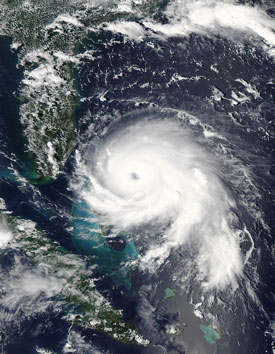
Hurricane Dorian devastated the Bahamas in September of 2019. (Photo: NASA, Wikimedia Commons, Public Domain)
DYKSTRA: Yeah, the information about melting ice has gotten worse. There's a new report that lists the best actors and the worst actors in terms of meeting the reductions goals committed to in the 2015 Paris Climate Accord. And the winner is, the best nation, the best behaved is, ladies and gentlemen, Morocco.
CURWOOD: Uh. Okay, I don't think Morocco is a leading culprit of CO2 emissions on the planet, though.
DYKSTRA: No, but to their credit, they've just brought a huge solar array online. There are a couple of really big CO2 emitters that are on the good list as well, India and the European Union.
CURWOOD: Okay, and who's at the bottom?
DYKSTRA: I'd say you'll never guess who's at the bottom, but you probably could guess who's at the bottom. It's Russia, the Saudis, and America.
CURWOOD: Of course. Hey, what else do you have for us today?
DYKSTRA: Well, there's a new law in Florida that says if you bring a developer to court over a controversy, whether it's mining or housing development, or any big environmental compromising project, and you lose in court, you have to pay the developer’s legal fees and all the court fees. Environmentalists have called this quote, "a mortal blow to growth management." It's already a lopsided financial battle between developers, and whether it’s citizens groups or nonprofit conservation groups, this law would make it more lopsided in one of America's most lopsided climate states, which is now more lopsided.
CURWOOD: indeed. Hey, what do you see when you look back in the annals of history?
DYKSTRA: Well, we may make history this week. Mid September is the standard period for Arctic ice cover hitting its summer seasonal low. NASA has an animation showing how we did in 2019. And it's not pretty. But wait, there's more! There's an anniversary of a potential climate fix.
CURWOOD: And that is?
DYKSTRA: Hurricane Gloria back in 1985, on September 25, took an abrupt turn northward. It was headed straight for Virginia Beach, Virginia. Virginia Beach was spared when the hurricane turned north. And the Reverend Pat Robertson went on TV to take credit for praying Gloria away from his Virginia Beach headquarters.
CURWOOD: But, where did the storm wind up?
DYKSTRA: It made landfall in Long Island, went through to Connecticut and took seven souls.
CURWOOD: Hm. Hey, thanks, Peter. Peter Dykstra is an editor with Environmental Health News. That's EHN.org and DailyClimate.org. And we'll talk to you again real soon.
DYKSTRA: All right, Steve, thanks a lot. Talk to you soon.
CURWOOD: And, there's more on these stories, as well as a link to the animation of the loss of ice that was put together by NASA, at our website LOE.org.
Related links:
-
The New York Times : “Tropical Storm Karen Could Loop Toward the Bahamas and Florida”
- National Geographic : “Climate change report card: These countries are reaching targets”
- Check out NASA’s animation on 2019’s Arctic sea ice levels
- Pat Roberts broadcast claiming prayer moved a hurricane
[MUSIC: Sparky & Rhonda Rucker, “Midnight Thirst” on Midnight Memories, by James David Rucker, Jr., Tremont Productions]
Container Farming in the City
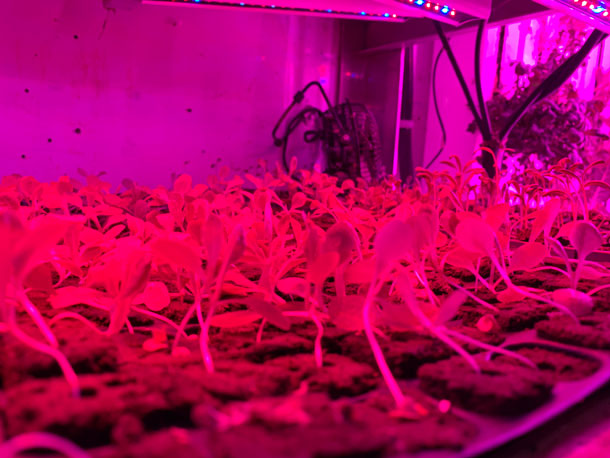
Corner Stalk Farm grows an acre’s worth of lettuce in a shipping container that only takes up 320 square feet. (Photo: Jay Feinstein)
CURWOOD: Industrial agriculture today is a resource-intensive endeavor, requiring big machines, plenty of land, water, and energy to produce much of the food on a typical American dinner table. And as the public trends more toward plant-based foods, some are thinking outside the box by bringing farms inside the box. By retrofitting old shipping containers with grow lights and hydroponic gear, what would take about an acre of land to grow vegetables such as lettuce can be fit into just 8 by 40 feet. Living on Earth's Jay Feinstein and Aynsley O'Neill took a trip to Corner Stalk Farms in East Boston, Massachusetts to find out more.
GPS: Your destination is on the right.
O’NEILL: The only other time I've been to East Boston was to go to the airport. So I'm a little surprised at how busy it is. And I see these shipping containers. I mean, right in the middle of these houses and behind the auto body shop...but, here we are!
FEINSTEIN: You know, the funny thing is a farm like this would not have even been legal until 2013, when Boston revamped its zoning code.
O'NEILL: I didn't even know that someone would make a farm illegal.
FEINSTEIN: Yeah, I know, right?
O'NEILL: Do you think that's the guy up front?
FEINSTEIN: Yeah, I think so.
O'NEILL: He's a little less sunburned than most farmers.
COONEY: My name is Shawn Cooney. And I'm the partner and owner of Corner Stalk farm in East Boston, Massachusetts, and we started in 2014. So this is it. So we...there's not too much to it. I mean, it's basically you've seen the whole of the farm by walking the 120 feet or so.
FEINSTEIN: That's amazing.
COONEY: And we've got four units that are you know, basically growing lettuce year round. And, you know, that's it. Do you wanna go inside?
O'NEILL: Yeah!
FEINSTEIN: We'd love to.
COONEY: Cool.
O’NEILL: Well, it's definitely a few degrees cooler in here.
FEINSTEIN: And these lights are blinding. I mean, these red and blue lights, LEDs, it’s something like out of a sci fi movie.
O'NEILL: Are those the plants in those columns all up and down?
COONEY: Right. You really need just an industrial area, You need a, you know, a place where you can basically bring as many plants as possible into as little amount of square footage as possible. So we kind of look at it as cubic feet. In a real farm, you're talking about square footage and acreage. Here, it's really cubic feet. We've got so many feet on the floor, but we plant plants up to ten high.
FEINSTEIN: So, show us around.
COONEY: Okay, so basically, you walk in and we're in a complete self-contained farm. We've got a climate control system, and a lot of fans keep the air moving so that everything's happy. And the plants get a little bit of stress. If you just leave them without any movement, the plants actually get weak.
O'NEILL: Wait, so they need exercise? They're lifting weights, they're jumping jacks, they're?
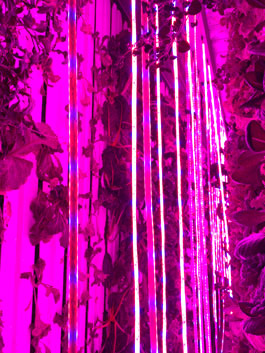
The shipping container uses a combination of red and blue LED grow lights and hanging hydroponics to grow their plants. (Photo: Jay Feinstein)
COONEY: Uh, pretty much yeah, it's stressing the plants is what it's really called in the industry, but they do need to be moved around for them to have a good texture to them, so that the cell walls are thick enough, so that it's not just eating a piece of water.
O'NEILL: And you can maintain it all using a box on the side of the container.
COONEY: Yeah, there's a tiny little antique style computer that's, that's very industrial. And you can log into it from the outside world. If you want to fiddle around with settings, or just check on everything, you can do that from home, you can do it from from vacation, you can do it, whatever.
FEINSTEIN: So how did you get into this?
COONEY: I started three software companies and sold them. And I started doing business plans, looking for the next thing, and one was the ag tech farming. This kept coming up is something that was interesting. Dug a little further, did a little more business planning, and it won. My wife and I self funded it, and we have loans and the loans are from the US Department of Agriculture, like a regular farmer would get his loans.
FEINSTEIN: So what are you growing in here?
COONEY: Well, mainly we grow lettuce. That's our business. And we've grown tomatoes, we've grown lots of flowers, we've grown all kinds of herbs, and God knows what else. But it turns out that as a business, you have to sell what people buy every day. And what people buy every day is our greens, even our restaurants, that's what they want.
O’NEILL: Well, so you sell to individuals and you sell to restaurants.
COONEY: We sell, we sell to both, we sell probably 50/50. We sell to a bunch of nice restaurants in the Boston, downtown Boston area. We deliver to them. And we sell to regular consumers.
FEINSTEIN: But still most of your customers, are they still in Boston? Because that's hyper local, when you think about it. You growing in Boston, you're selling in Boston?
COONEY: Oh, yeah. Yeah, no, they're all in the metro Boston area. A lot of Cambridge customers. But it is, you know, it is basically a hyper local thing. The reason we keep the customers is it's a better product than what you can by at, you know, pretty much anywhere. Basically what it comes down to is it looks better. It tastes better, and it's got more nutrients, and it feels better. It's got better texture. So that's kind of what people are buying.
FEINSTEIN: Tell us more about hyper local, it's sort of a buzzword nowadays. People say it's better for your health; it's better for the environment. Is that true?
COONEY: Pretty much, yeah, it's true. And it's got a downside. The downside is it's probably a little more expensive also. But it is - any vegetable, once you harvest it, loses some somewhere around 7% of its nutrient value every day from the day they're harvested, up to a point. And they lose a lot of their texture, and their attractive qualities. What we sell is still alive, we sell the lettuces with the roots on them. You get a much better life cycle lot of them that way. So they're, they're basically not losing any nutrients. And they maintain their freshness. If you ever had the experience of buying a nice box of brand name, cut lettuce in a plastic bin, that looks great, and you get home and then two days later, it smells funny and you've got black sludge on the bottom. That won't happen with what we're selling.
O'NEILL: I was wondering because there are times when I have bought, like you said, cut lettuce from the grocery store. And it's a race against the clock.
COONEY
I mean, that's one of our biggest customer satisfaction points, and our selling points was that you get to use it all. It's not like you're buying a $10 package of lettuce and using $3 worth. You know, with us you buy a $10 package of lettuce and you get to eat $10 worth of lettuce. But you can go on vacation, you can go on a business trip, and you can come back and still have something in there that's perfectly palatable.
FEINSTEIN: What type of environmental cost are you saving?
COONEY: Regular farming is a "grow as much as you possibly can and sell it when it's ready, as fast as you can". We’re an on-demand business, because we don't grow extra. We’re growing pretty much what we're selling, give or take a little bit. You know, and one of the things we definitely don't do is waste any water. No matter how good you are at growing outside, you could never grow with the kind of water use we have. We use, say 1000 plants we can grow in one unit, we probably use 25 gallons of water a week. So you couldn't water your patio plants for a week with 25 gallons and keep them alive.
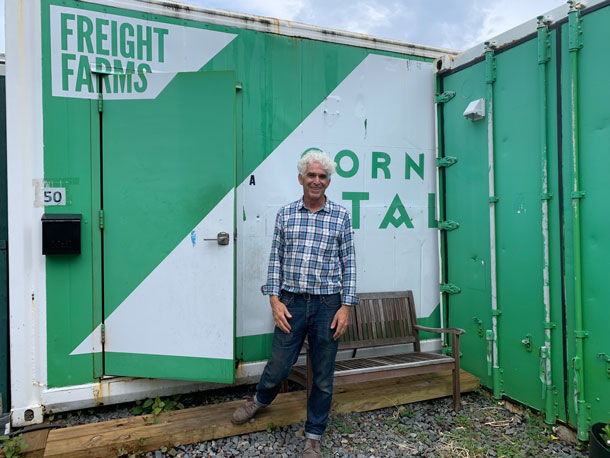
Shawn Cooney and his wife Connie (not pictured) own Corner Stalk Farm, in East Boston, Massachusetts. (Photo: Jay Feinstein)
O’NEILL: So what was the inspiration behind deciding to build a farm inside? And I don't mean in a greenhouse. And I don't mean in a window box or anything like that? What was the shipping container idea?
COONEY: Part of it is, it's a durable, clean environment that can put up with the stresses that farming puts on a space. And basically there's all kinds of stuff that goes on in here that would basically bring down a building. You know, it would ruin the walls, you couldn't clean it. If something ever happened in here, we had some kind of a mold infestation or something. You could shut everything off. And you can sanitize this place just like you would the clean room in a restaurant or a food processing center.
FEINSTEIN: To what extent do you use chemicals in here?
COONEY
We do use them once in a great while. We can't be organic because we don't grow in dirt, it’s a water based environment, but we adhere to the organic principles. Generally, the way we control any kind of a pest in here is kind of preemptive. We basically use ladybugs. We ship them in once a month or so, and sprinkle them around, and they pretty much do the policing of any kind of bugs in here. And when we have had to use something it's called chrysanthemum oil.
O’NEILL: May I ask? May I try some of the lettuce?
COONEY: Sure. Okay, well we harvested some
FEINSTEIN: What is it?
COONEY: This is the Salanova Red Butter. There's not many people who actually have favorites, but if they do, this is the one that they want. So go ahead, have a taste.
O'NEILL: Sure looks like normal lettuce...
[SFX CHEWING]
O’NEILL: I don't mean to sound incredulous, but I'm a little incredulous. Might I have another one?
COONEY: Sure.
O'NEILL: Alright.
COONEY: Finish them all.
FEINSTEIN: It's very green.
O'NEILL: It's very green.
FEINSTEIN: I’m gonna try this too.
[SFX CHEWING]
FEINSTEIN: Wow, you can taste like it was grown right here. It was.
O'NEILL: It's definitely fresh. I mean, you literally just clipped it right in front of us. But it's... that's... I've never had lettuce like this. This I would eat. on its own, I don't even feel like I need to be you know, putting salad dressing on it. Or, oh, I need a crouton or something.
FEINSTEIN: And this is a weird thing to say too. But it kind of feels alive.
COONEY: You guys want to try something a little, little further on the edge? This is called wasabi arugula. And I grow it for a couple of restaurants. And they use it instead of wasabi on their crudo and their raw fish and their raw meats. So here, take a leaf of that and be prepared.
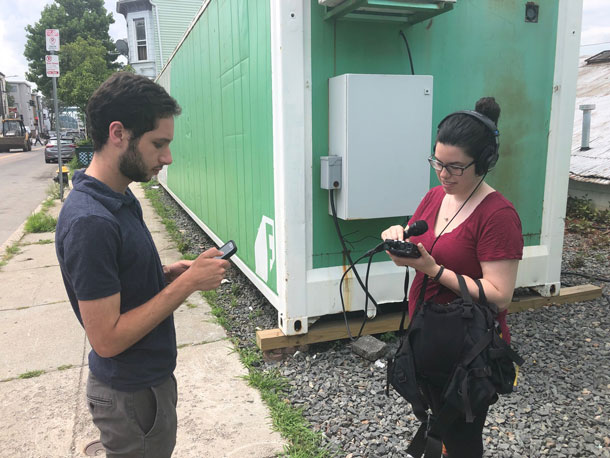
Jay Feinstein (left) and Aynsley O’Neill (right) prepare their notes and audio equipment outside Corner Stalk Farms. (Photo: Steve Curwood)
FEINSTEIN: All right, I'm prepared. I don't know what to expect here.
[SFX CHEWING]
FEINSTEIN: It does taste like wasabi. But it it's a little milder, but I love it actually.
O'NEILL: I myself am a little terrified. I have an all time low tolerance for wasabi.
[SFX CHEWING]
O’NEILL: Well, it is a bit much for me, but it is really good. And I'm a little astonished that it's not coming in those tiny little balls of green mush.
COONEY: It's actually a real arugula, and it just happens to have that flavor profile. It's not related to wasabi at all. It's the same as the arugula you buy in the plastic package, family wise.
O'NEILL: Well, I know that some people will call arugula "rocket". And that was certainly, you know, a blast off of flavor.
COONEY: Yeah, this is much closer to the rocket family part of arugula than the general arugula you buy in the store.
O'NEILL: So what do we owe you now? 10 bucks for the lettuce, and how much for the arugula?
COONEY:10 bucks for the lettuce, and the arugula is free.
O'NEILL: Well, I think we're all ready to head out. Thank you again for showing us around.
COONEY: Oh, you're welcome.
FEINSTEIN: Thank you so much.
COONEY: Thanks for coming. I appreciate everyone's time.
CURWOOD: That’s Living on Earth’s Aynsley O’Neill and Jay Feinstein with farmer Shawn Cooney at the shipping container called Corner Stalk Farms. And by the way, we ran some numbers, and found that the shipping container farm is using 99 percent less water than a traditional farm would use to grow the same amount of produce. The farm is also saving on the order of 5 metric tons of carbon dioxide in shipping for each crop, which is roughly what would be emitted to truck the same amount of lettuce from California to Boston. Around 300 of these types of shipping container farms have been sold as of now. This story is part of our series, Cool Fix for a Hot Planet. For pictures and more visit our website, LOE.org.
Related links:
- Corner Stalk Farm
- Freight Farms, the creators of the shipping container farms used by Corner Stalk
[MUSIC: Grant Green - "Iron City” from the album Iron City (1967) Cobblestone Records]
CURWOOD: Living on Earth is produced by the World Media Foundation.
Our crew includes Naomi Arenberg, Bobby Bascomb, Paloma Beltran, Thurston Briscoe, Jenni Doering, Jay Feinstein, Merlin Haxhiymeri, Don Lyman, Lizz Malloy, Aynsley O’Neill, Jake Rego, and Jolanda Omari. Tom Tiger engineered our show.
Alison Lirish Dean composed our themes. You can hear us anytime at LOE.org, iTunes and Google play- and like us, please, on our Facebook page - PRI’s Living on Earth. We tweet from @livingonearth. And find us on Instagram at livingonearthradio.
I’m Steve Curwood. Thanks for listening!
ANNOUNCER: Funding for Living on Earth comes from you, our listeners, and from the University of Massachusetts, Boston, in association with its School for the Environment, developing the next generation of environmental leaders. And from the Grantham Foundation for the protection of the environment, supporting strategic communications and collaboration in solving the world’s most pressing environmental problems. Support also comes from the Energy Foundation, serving the public interest by helping to build a strong, clean, energy economy and from Carl and Judy Ferenbach of Boston, Massachusetts.
ANNOUNCER 2: PRI, Public Radio International.
Living on Earth wants to hear from you!
Living on Earth
62 Calef Highway, Suite 212
Lee, NH 03861
Telephone: 617-287-4121
E-mail: comments@loe.org
Newsletter [Click here]
Donate to Living on Earth!
Living on Earth is an independent media program and relies entirely on contributions from listeners and institutions supporting public service. Please donate now to preserve an independent environmental voice.
NewsletterLiving on Earth offers a weekly delivery of the show's rundown to your mailbox. Sign up for our newsletter today!
 Sailors For The Sea: Be the change you want to sea.
Sailors For The Sea: Be the change you want to sea.
 Creating positive outcomes for future generations.
Creating positive outcomes for future generations.
 Innovating to make the world a better, more sustainable place to live. Listen to the race to 9 billion
Innovating to make the world a better, more sustainable place to live. Listen to the race to 9 billion
 The Grantham Foundation for the Protection of the Environment: Committed to protecting and improving the health of the global environment.
The Grantham Foundation for the Protection of the Environment: Committed to protecting and improving the health of the global environment.
 Contribute to Living on Earth and receive, as our gift to you, an archival print of one of Mark Seth Lender's extraordinary wildlife photographs. Follow the link to see Mark's current collection of photographs.
Contribute to Living on Earth and receive, as our gift to you, an archival print of one of Mark Seth Lender's extraordinary wildlife photographs. Follow the link to see Mark's current collection of photographs.
 Buy a signed copy of Mark Seth Lender's book Smeagull the Seagull & support Living on Earth
Buy a signed copy of Mark Seth Lender's book Smeagull the Seagull & support Living on Earth

